It’s baffling out there. Advice about growing avocado trees in containers comes from every direction and often conflicts. Should you use a potting mix that includes organic materials? Which kind of pot should you use? What’s the best variety for growing in a container? Can you actually get fruit from an avocado tree in a container, anyway?
No one can agree.
Here I come to add to the chaos. But my objective is to give clear and reliable information, as I will only talk about my firsthand experience and what I’ve personally seen other successful growers of avocado trees in containers doing. With that, I hope that I can help you have similar success.
Potting mix
The most contentious issue is what kind of mix is best. More to the point, some believe that plant materials such as wood chips or compost should be a part of the mix while others don’t.
The issue is solved through simple observation. If you travel around and look at avocado trees in containers at nurseries and in yards, you discover that various mixes grow healthy avocado trees, including mixes that contain wood chips or compost.
Allow me to show you a few examples of trees I have visited over the years and tell you what mixes they are growing in. You might like to emulate one.
1. The grower of the two trees below is located in San Diego, and he uses mostly his native dirt along with Kellogg’s GroMulch, plus a little coffee grounds and horse manure. You can read the ingredients of the Kellogg’s GroMulch in the link, and note that it is mostly wood chips/compost (“recycled forest products and aged arbor fines”).
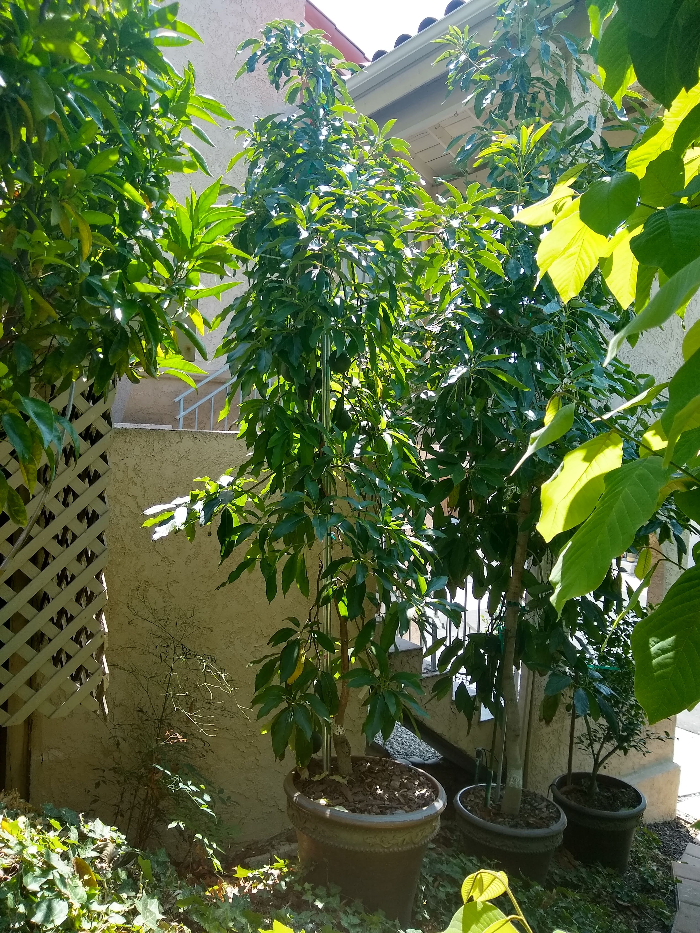
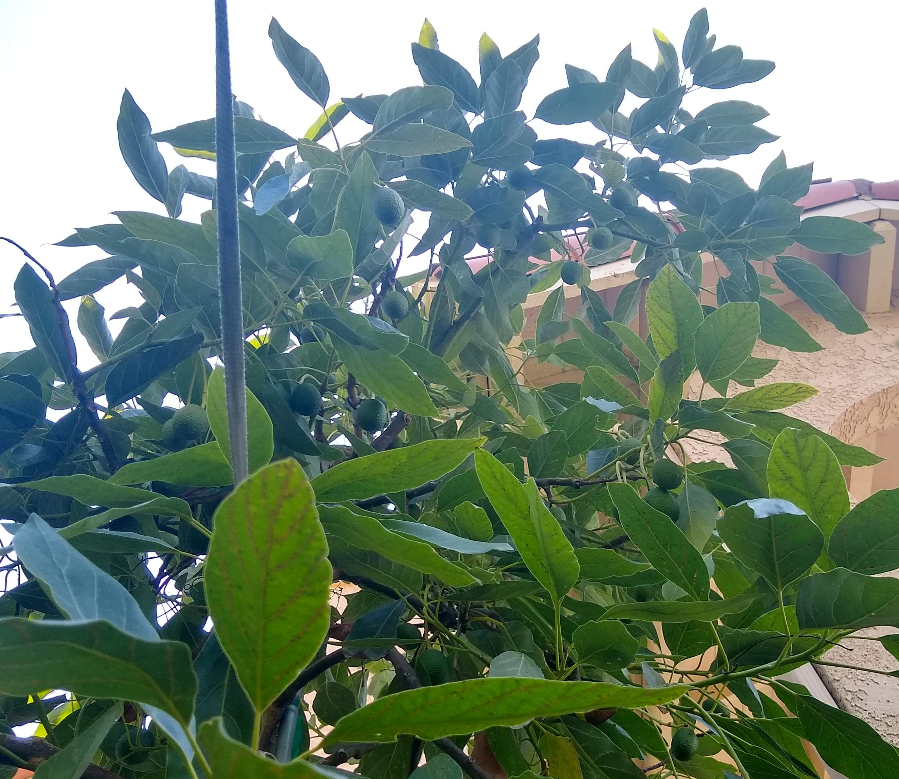
2. The grower of the seedlings below has started dozens and dozens of his own trees for grafting and planting into his grove. He uses E.B. Stone’s Cactus and Succulent mix, which is made of (in order of volume from most to least) pumice, aged fir, aged redwood, lava rock, and sand.
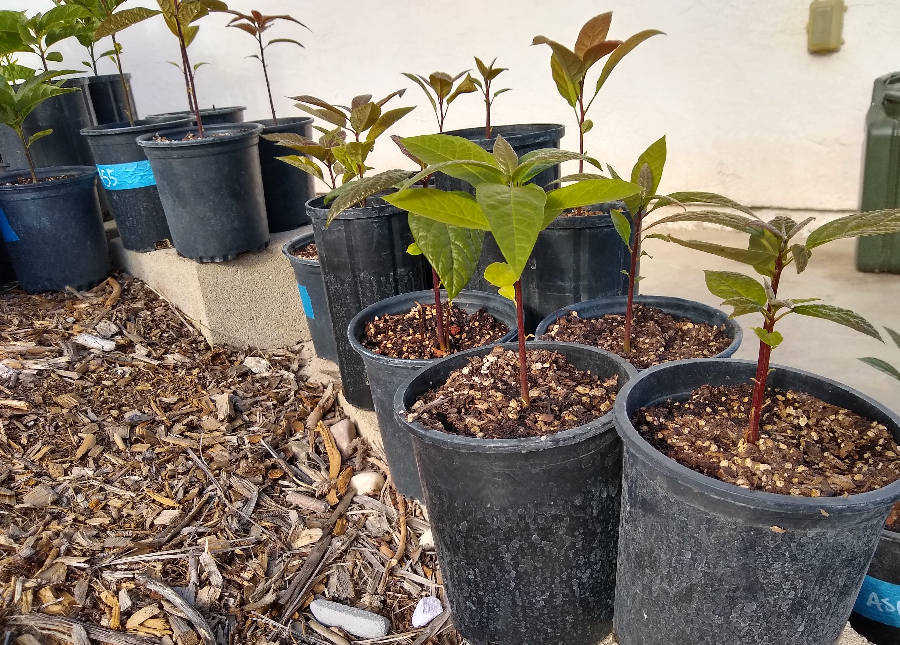
Commercial nurseries in California grow hundreds of thousands of avocado trees in containers each year and they have fine tuned their potting mixes into the recipes that they think grow the best trees while keeping costs as low as possible, among a few other concerns. Their potting mix recipes are their trade secrets so they are not always keen to share exactly what is in their mix, but I do know the major ingredients of the mixes used by a couple of good nurseries and I don’t think they would mind my sharing those.
3. Brokaw Nursery in Ventura includes in their potting mix: wood chips, sand, soil, and coco coir.
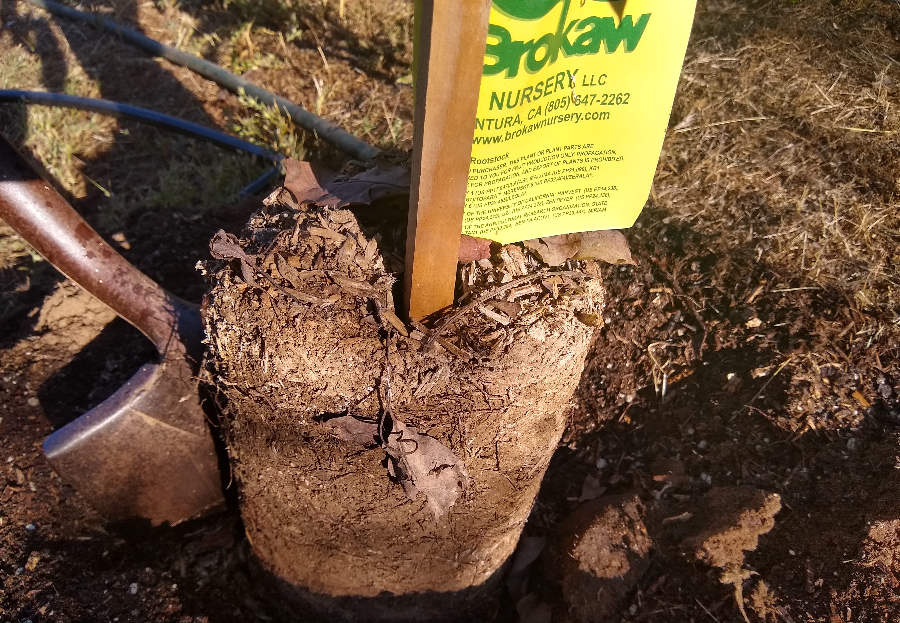
4. Maddock Ranch Nursery in Fallbrook includes in their mix: soil and redwood chips.
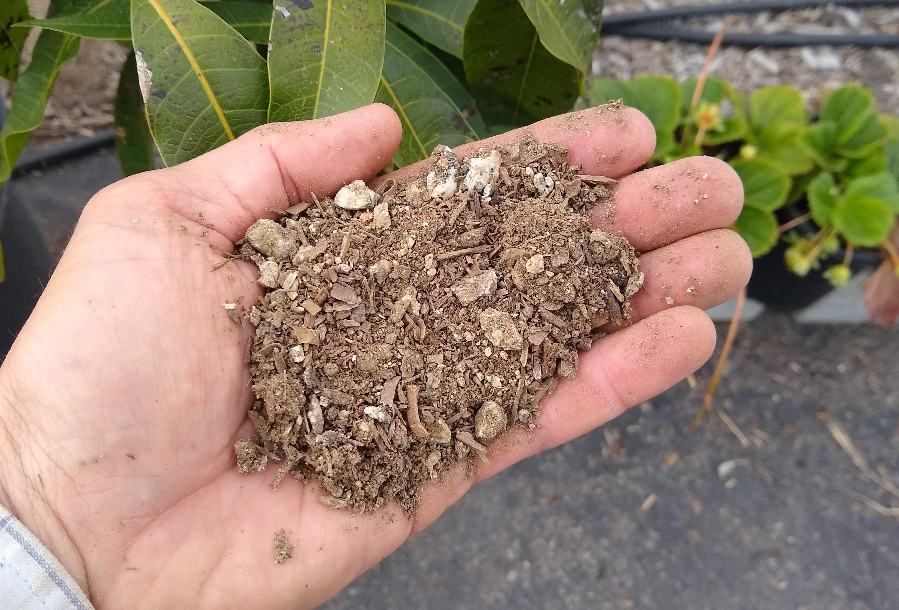
5. Researchers at the University of California have grown thousands of avocados in containers over many decades and they have published the ingredients used in their mixes. In “Propagating Avocados” it is written, “At UC Riverside, we use UC #2 soil mix . . . based on ½ sand, ¼ peat moss, and ¼ nitrogenated redwood compost, plus added nutrients.”
6. While I don’t grow any avocado trees in containers long term, I often start my own trees from seed in containers in order to graft and later plant in my yard or give to friends. I usually use my homemade compost for these trees, which contains a bit of dirt and chicken manure, but is mostly composted wood chips and garden scraps.
7. A few times I have grown avocado trees in Recipe 420 mix with good results also. Recipe 420’s main four ingredients are (in order of volume from most to least) aged fir bark, coir, peat moss, and pumice.

All of the above mixes grow excellent containerized avocado trees, in my observations. Make your own mix using them as a reference or buy one of the bagged mixes (E.B. Stone’s Cactus and Succulent or Recipe 420), and you will be off to a good start.
Fertilizing
Similar to the variation in mixes used, I’ve seen that successful growers fertilize their container avocados in different ways. One nursery grower told me she fertilizes her container avocados with urea. Another uses True 4-4-2. A few friends use Osmocote on their avocado trees in containers and get good growth.
Here are some Hass trees growing in containers at Westfalia in South Africa, grown by Omar Diaz, in a mixture of sand and peat moss, and fertilized with Osmocote. Tell me what Omar is doing is not working!
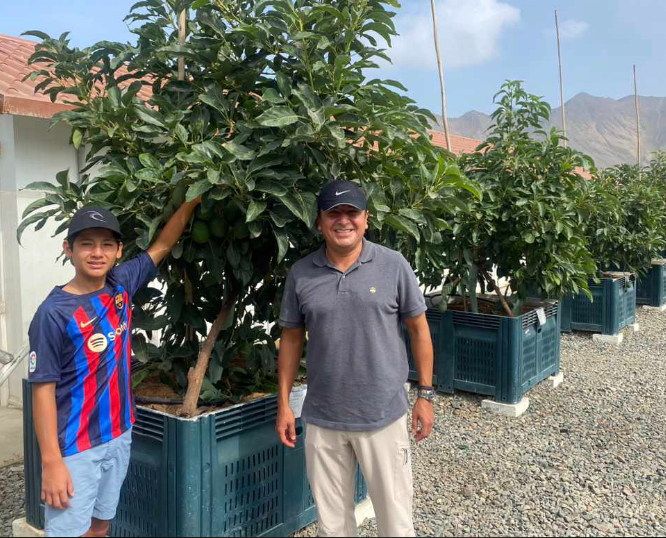

Types of containers
The containers used for Omar’s trees above are harvest bins made of plastic. Is plastic the best material for containers for avocados? And they are square. Is square the best shape?
When Bob Bergh was breeding avocados for the University of California, he grew trees in 30-gallon metal trash cans. “It has been found that trees in the largest cans will mature a maximum of only about 30 fruits under our conditions,” wrote Bergh in 1957.
Plastic, metal, square or round, I don’t think the container material or shape matters much, based on the fact that I’ve seen healthy and productive trees in so many different combinations.
But there is one characteristic that all of these containers share, and that is drainage, in other words, holes — especially holes near the container’s bottom. There must be numerous holes at the bottom of the container because avocado roots cannot stand low oxygen: they need to breath.
Note the happy white avocado roots inside this sleeve that has abundant holes in the bottom half. (Tree is from Subtropica Nursery in Fallbrook.)

Note that this tree below in a sleeve from Brokaw Nursery doesn’t even have a bottom! Now that is drainage.
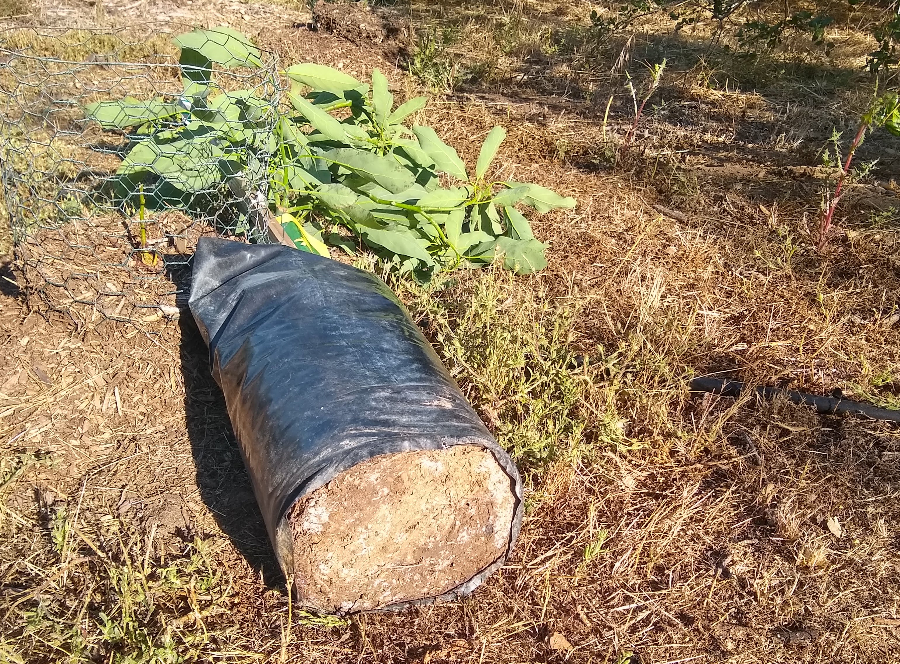
It can further help drainage to place the containerized avocado tree up on bricks or a pallet, especially if the surface below the container will not sufficiently drain water away — for example, if the container is on concrete.
A final note on containers: The sunny sides of a container can heat up so much that roots won’t grow there. See below.
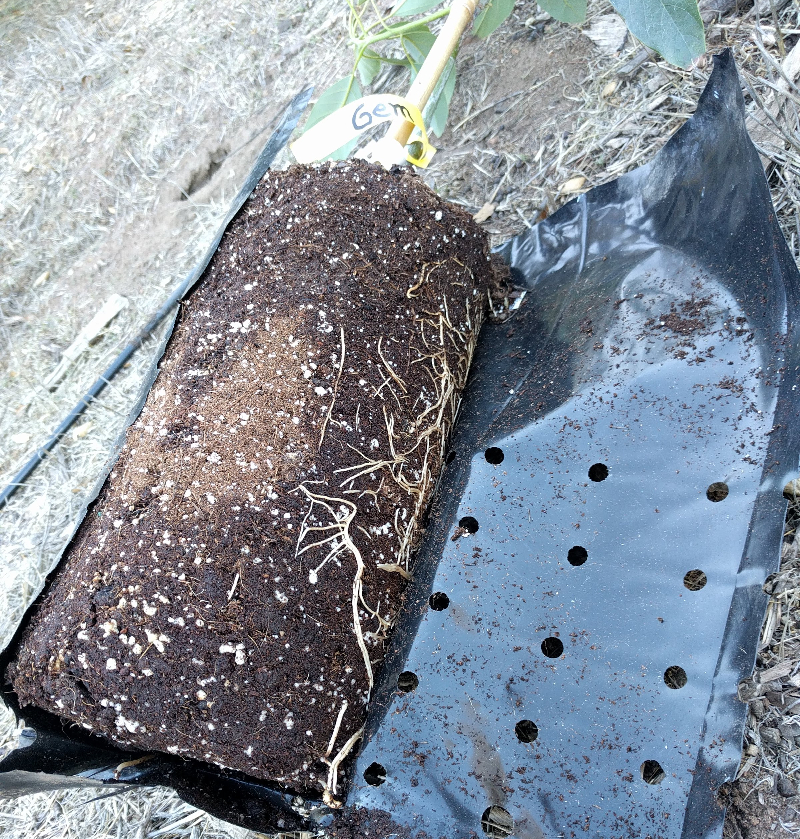
Because of this, I wrap my containers with shade cloth or reed fencing, or I paint the southern half of the container white to reflect sun and cool it.
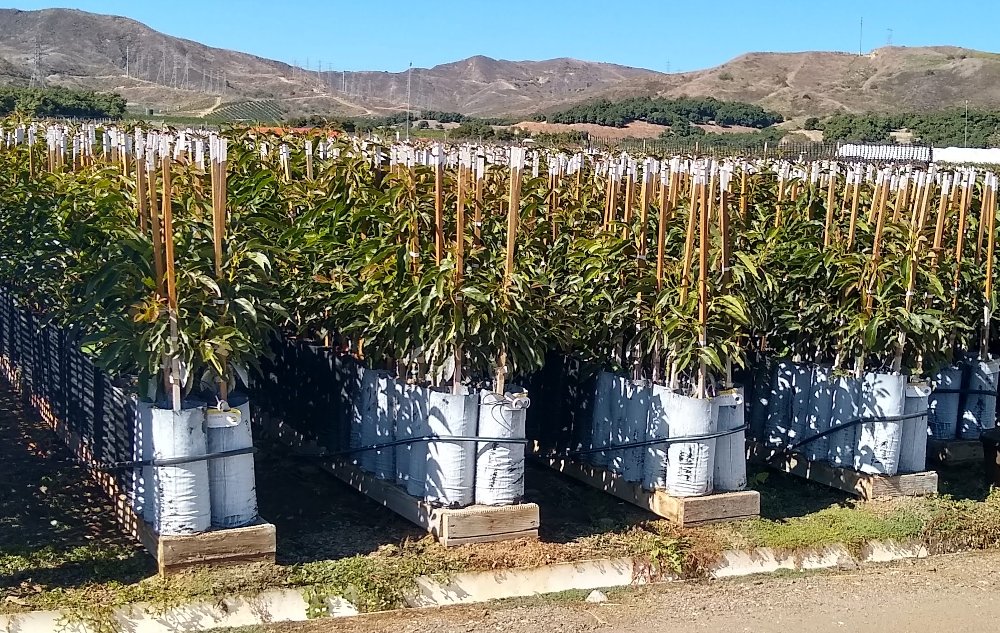
Watering
In general, an avocado tree in a container is likely to need watering more often than one in the ground. That is partly because the potting mixes used don’t usually hold as much water as dirt.
But how often to water depends on the mix used (how much dirt does it contain?), how big the tree is relative to its container, and how sunny and windy it is.
One avocado nursery owner told me they water their avocados in containers every day in summer and sometimes twice per day while in winter whenever there is no rain they still water almost every day.
I don’t water my container trees quite that often. I water every 1-2 days in summer. How to know when to water an avocado tree in a pot? I lift the container to feel the weight. If it’s relatively heavy, then there is still a lot of water inside. If it’s light, then I need to add water. (Of course, this only works for smaller pots.)
You can water by hand or you can use drip emitters. I use drip on some of my potted avocados, and so do some nurseries.
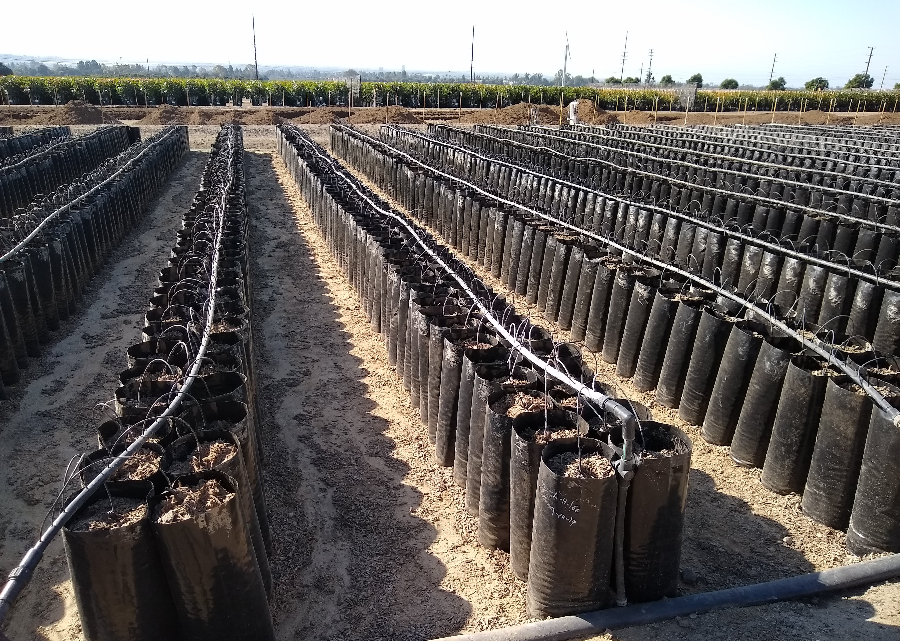
Varieties for containers
Which avocado variety is best to grow in a container? If you’re looking to get fruit from the tree, then I would go with a precocious variety, for that would be one that will start fruiting while the tree is still small. Precocious avocado varieties include Reed, GEM, Gwen, and Lamb.
Pinkerton is precocious but it doesn’t fruit well unless there is another avocado variety nearby, in my experience. So I would only choose Pinkerton if I were growing more than one variety.
Hass is not as precocious as the varieties above but can certainly still fruit while in a container. You have seen evidence of that in the photos above. Here’s one more:
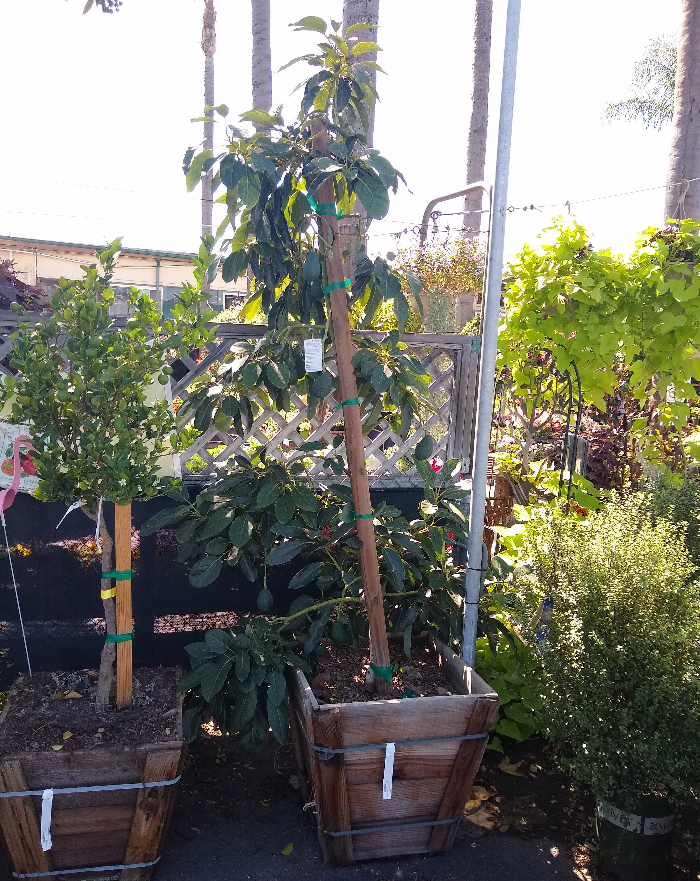
If I were getting really deliberate about growing a fruiting avocado tree in a container, then I would also select a rootstock that tends to induce bearing at a young age. For seedling rootstocks, I would try Gwen or Pinkerton. For clonal rootstocks, I would try Dusa or Ben Ya’acov 1 (VC66). But I don’t think the choice of rootstock is critical.
I leave you with this tree in the ground in my yard that I think could have been a good container tree. It is a Gwen that I grafted onto a Gwen seedling rootstock. It is only as tall as me today, and yet it set 35 avocados this spring.
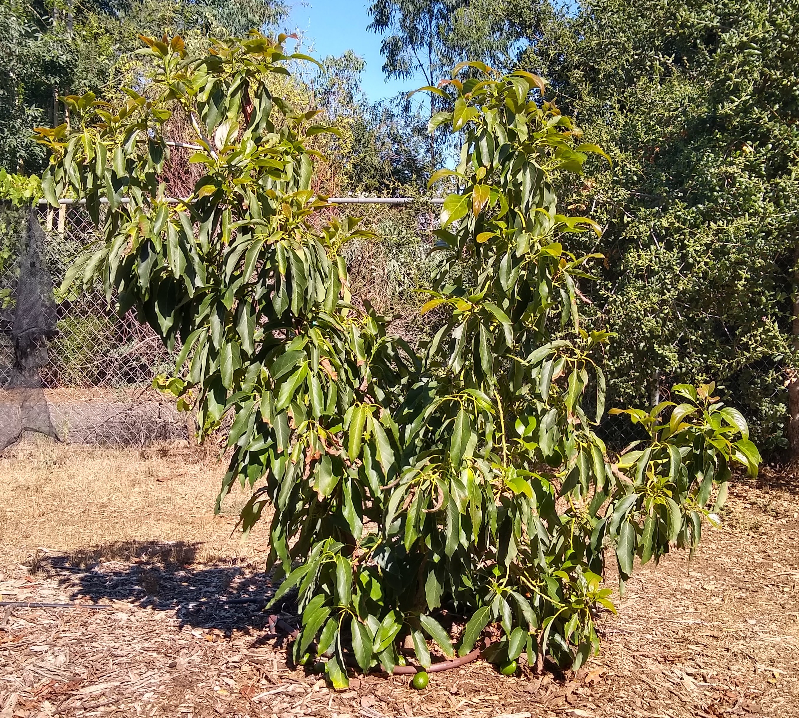
I hope your container avocado trees are even more fruitful.
Thank you, Supporters! I’m able to write these Yard Posts (and not clutter them with ads) because of your direct support.
All of my Yard Posts are listed HERE

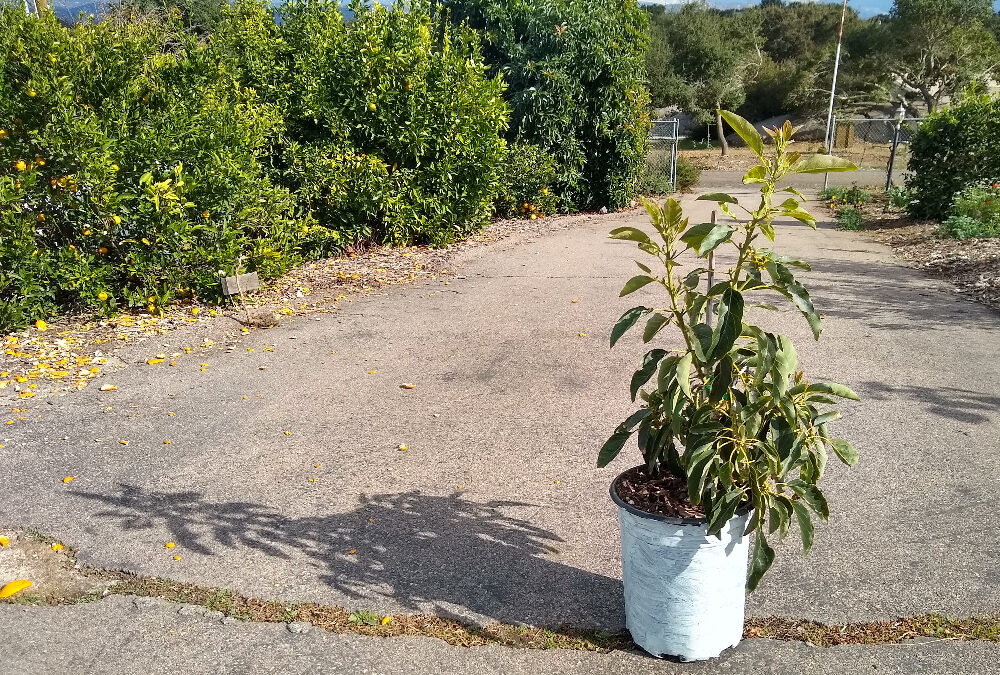


I know that a lot of people would like to grow an avocado in areas where it gets too cold. I wish them success with these tips because the avocado is a beautiful plant.
I have an abocado tree about 6’ what should I do with it so it will keep on growing inWinter season its in a container ,n what fertilizer I have touse to make ir stronger ,thank u very much
Probably won’t need much fertilizer in the winter. If you see a growth flush, give it some dilute fertilizer. Don’t overwater. Good luck!
Why is my container avocado getting buds in November in
Northern VA? Was outside all summer
I’m in 9a but we still get hard frosts. For me, I take mine inside (on thick gauge plastic to protect the floor). Hope that helps a bit 🤙🏼
Kristen,
Just moved to 9A from down south. I brought my avocado tree with us. It’s potted and about 4 ft. I would love to know more about this area and growing my tree.
Me too, Randy. At the same time, I’ve been surprised to discover how many people here in Southern California “avocado country” also grow avocados in containers.
Their reasons are myriad: they think their soil is terrible; they don’t have space for a big, in-ground tree; they plan to move within the next year or two; the sunniest spot in their yard is a concrete patio.
I just met a guy yesterday who lives in Chula Vista and grows numerous beautiful avocado trees in half-wine barrels. Chula Vista! Is there an easier climate in Southern California in which to grow avocados? But he’s trying to fit many varieties into his yard and it doesn’t have enough open dirt space.
That’s pretty cool! I have to admit, there were days when I would have liked to get some little trees out of the weather for a day or a week or a month when they were cooking in the sun (some didn’t make it). I was surprised how well some tomatoes did in containers this year. When you gotta grow, you gotta grow!
Hi Greg! I have an Ismael avocado that I need to up pot. I’d love to plant in ground but I don’t have room in my small yard. Someone gave it to me and I have only found a handful of mentions about it online. I can’t find whether or not it is container suitable. Have you heard of this cultivar and its growing habits, specifically for containers? The only info I found online is that it is West Indian, comes from Cuba and gives very large fruit.
Hi Liz,
I don’t know anything about the Ismael avocado variety other than what you have also found online. I read about it here: https://www.myavocadotrees.com/ismael-2.html
What size container would be ideal for a container-grown avocado, and how long can a tree last in a container before it loses vigor from lack of space?
Hi Cynthia,
The ideal container size is the one matched to the tree size. If the tree is too small for the container, then the mix inside can stay too wet for too long and rot the roots more easily. If the tree is too big for the container, then the tree will need water very frequently and will ultimately be stunted if not up potted.
An example of a good match is a tree that is two to three feet tall in a container that is about a foot wide and deep. (Notice that my tree at the top of this post is a bit small for its container. Because of this, I have to be careful not to keep the mix inside too wet. On the upside, I won’t have to up-pot it for a while.)
How long an avocado tree can last in a container is a great question, to which I don’t know the answer. I have read of people keeping them healthy in containers for more than a decade though. For example, Bob Bergh of the University of California kept Gwen trees in containers (30-gallon metal trash cans) that he would use to cut budwood from. He wrote, “A single, older container tree . . . at the time of its removal last spring it was 16 years old. 15 feet tall with about 12 feet spread at its widest.”
See: http://avocadosource.com/CAS_Yearbooks/CAS_70_1986/CAS_1986_PG_079-090.pdf
What time of year should I repot my tree I keep it inside year round the winter months here are long and cold.I am growing my tree’s from seed .I just want my tree’s for plants.
Hi Lynn,
I don’t think there is a better or worse time of year to repot an avocado tree, especially one like yours that is kept indoors and not subject to stressful weather.
Thank you
Is it okay if my tree is 4″ at three years old?
Do you have to graft the tree to get any fruit?
I have an unusual seedling tree I got from a friend. She said it has fruited. It’s only about 2 feet tall but with a 1.5” diameter trunk so it’s hard to tell but probably 5 years old at least. The top looks good but it has very little roots. I’m curious what this would do if grafted to a Bacon seedling. Would it become a regular grafted tree or retain the dwarf fruiting quality?
My avocado tree in a container leaves are yellowish what can be the problem. ?
Hi Peter,
Yellowish leaves on an avocado (the whole canopy, not just a couple individual leaves) can be caused by many things, but the most common causes are overwatering or lack of soil nutrients.
I would check the potting mix at the very bottom of your container to see if it is soggy and if the roots there are brown. If so, then you have been watering too much and too often.
If the mix down at the bottom is not soggy and the roots are white or cream colored, then the mix might lack fertility.
Hi Evan,
If you grafted a variety that is small onto a Bacon seedling, it will mainly keep its small characteristics. The rootstock has some effect, but not as much as the scion.
Hi Greg! I am in Buellton, Ca, 45 minutes north of Santa Barbara county, in wine country. It says I am in zone 10a for growing, and I’ve been told that avocados do not like it here, although there are countless avo field crops both north and south of us. I have a small container avocado tree that I have propagated from a seed and had grafted. I am VERY proud of this little tree, and I really want to see it fruit someday. My question for you is: Do you think I can make it work here? We get hot sun and wind in the summer, spring and fall and cold temps in the winter. I have all my plumeria trees in containers and a greenhouse.
Hi Sheryl,
I drove through Buellton a couple weeks ago on my way up to San Luis Obispo. You are likely to be a bit hot and cold for an avocado to be perfectly comfortable, but I would guess that you could make most varieties work, especially if you protect your small tree through any heat waves or cold snaps in its first few years. Avocado trees get a lot tougher after they gain some size.
I have 2 in containers that have spouted up about 10 » tall now from GEM seeds started in mid June. Once they sprouted at the top I moved them to 2 different locations that get sun at different times of the day. One area is harsher sun but shorter duration. The leaves on the plant in this area have a red tint to them, and a slight waviness. The other seedling has soft green flat leaves. Is this difference purely from location? Same soil, same age, same container. I’ll send you a photo. Thanks!
Hi Kathryn,
Thanks for the helpful photo. I think the difference in the leaf shape and color is mostly due to genetics. I say this because I also have a GEM seedling that has red tint and wavy margins on its leaves whereas I’ve grown other GEM seedlings that have flatter and greener leaves.
But I do think it is probably partly due to the location also.
My guess is that even if you put the trees in the same light, the wavy margins would remain on the one variety while the leaf colors would become more similar. If you try it, tell me what happens.
I grew up on Fuertes and Nabals; partial to the Fuertes and am not familiar with other varieties besides Haas. Of Reed, GEM, Gwen, and Lamb which do you feel is closest in flavor to the Fuertes? How different is the flavor with the other three? I never considered growing in a container but your blog has me thinking!
Nothing tastes quite like Fuerte! But in terms of best flavor, which is similar to saying most like Fuerte, I would rank Gwen and GEM a tad higher than Reed and Lamb.
A factor that must be considered when people living in cold climates see a post like this is Greg’s examples of success are outdoors in ideal avocado growing regions.
I’ve grown a couple hundred avocado seedlings in the last few years here in Seattle, both in a greenhouse and outdoors. In the warm, dry summer (outdoors), they need water nearly daily in anything under a 7 gal pot, and even 15 gal need a weekly soaking.
In our cool winter, huddled together in a damp, dark greenhouse, they should be watered only about once a month (deeply). If they are watered much more frequently, a large percentage will start to show signs of root stress. This is true to some degree regardless of the potting mix used, but trees in potting mixes with a large percentage wood chips have done worse than the ones that are mostly aged compost and sand/perlite.
The good news is that seems to only apply to container trees. The ones in the ground outdoors or in the greenhouse seem to be quite content with the winter rains. But I’ve got subsoil with excellent drainage, I’m sure it would be different in muddy clay or something.
That being said, even trees that show some root stress recover pretty fully once they go in the ground the next year, and most trees have no issues as long as they are watered minimally in winter. If I’m planning to keep them in a container for a second winter, they are potted up to 15 gal. I do not intend to try any for a third winter, but if I ever did, it would be in a 30+ gal pot. I don’t think I could keep an avocado happy in a container here long-term, but honestly I haven’t tried.
This is a good point, Winn. Thanks for mentioning it. I wrote this post for gardeners in Southern California and wasn’t thinking about the adjustments that need to be made by others.
But during travels I have seen some containerized avocado trees of others in colder climates and what I’ve seen aligns with your experience regarding backing way off the watering during winter. I would lean toward letting the tree get too dry rather than risk keeping it too wet in those conditions.
Winn, or Greg…what are the subtleties of “root stress” in containerized avocado trees? What signs should I be looking for to catch this problem in it’s early stages…
There are a few things you may notice, depending on whether the problem is a too-wet medium, too-dry medium, too-small container, or some specific root pathogen that got a foothold due to some combination of those things.
For excessive wetness in winter (no active growth), the first thing I’ve seen is older leaves getting chlorotic prematurely (not yet ready to shed), which often progresses quickly to necrotic leaf margins. The newest growth may also stay pale even with adequate N.
Leaves and branches droop slightly as the first sign of dry roots, and if that happens often or for extended periods, the old leaves become pale and often drop prematurely. There’s often overlap of wet root symptoms, like chlorotic/necrotic older leaves.
If you pull off the pot and the roots look black or have visible dead patches, that’s a clear sign of root health problems. They should be white or cream colored. If they are circling the bottom at all then they are ready for a larger pot, even if the entire pot isn’t filled with roots yet.
Greg:
Do you have any advice on potting avocado cuttings that have been sitting in water with rooting hormone? I’ve tried loose combinations of peat moss, perlite, and cactus mix in small plastic pots with good drainage and the cutting always turns black and dies. This has been done with cuttings that had small, white root “nubs.” Should I leave them in the water and let the roots grow longer before potting?
Donna,
It is very challenging to root avocado cuttings, and is virtually impossible for Guatemalan or Lowland (“West Indies”) cultivars. I’ve had some limited success with pure Mexican cultivars, which I have summarized in this thread on the Growing Fruit forum:
https://growingfruit.org/t/rooting-avocado-cuttings/34254
The gist is you need to start with growing tips with the newest leaves intact, not scionwood with the leaves removed, and it will take 6+ months for roots to form. Humidity domes are necessary for the first few months. And even then, success rates are low.
Thanks for your reply and the info, Winn. A dose of reality, it sounds like a much more complex task than I’m up for. 😀
Winn, your documentation indicates your success rate when you used an aquarium filter was the best media until the graft calcifies.
Would you let us know what you mean by aquarium filter? One in an active aquarium, one that is constantly immersed in water? Any guidance here is appreciated such as a model number or link ?
Thanks for your help
Any regularly changed or aerated water in a warm place probably would work, but I’ve had the best results when I remove the filter cover and filter medium from an Aqueon QuietFlow 10 filter that was running in a 10 gal heated aquarium, with a single male fancy guppy living in the tank.
I just stick the cuttings in the back where the charcoal cartridge usually goes, with stems in the reservoir where the water continuously flows through.
Any just to be clear, I only leave those until I see callus forming, then move them to potting mix under a humidity dome, on a heating pad if it’s winter because this is done in my cool/mostly unheated greenhouse.
Hi Donna,
Avocados are harder to root than many other plants. That is why nurseries today don’t do it. They go through a different time-consuming and complicated process in order to make “clonal” rootstocks, which are essentially rooted cuttings.
Let me know why you want to root avocado cuttings and maybe I can guide you down an easier path to achieving the same result.
Otherwise, I can only tell you what I have read about rooting avocados because I have zero experience with it!
Thanks for your reply, Greg. You asked why I wanted to root cuttings. I see that I simply didn’t know any better—until now.
I’m the person who first wrote to you about two very old avocado trees of unknown species on a family property we’d recently sold. I was trying to find out what they were and sent you a sample of the strangest one (though it was past its prime).
Between the two varieties, I tried a total of nine grafts on two small trees and none of them took.
I had some scions leftover from attempting to graft (in May). I ran out of branches on which to graft, so I thought I’d hedge my bets by trying to root the remaining scions. Some of them sprouted tiny leaves, so I thought I was on the right track.
Now I’ll have to wait until grafting season again, hope that more branches grow on my little trees, and hope the property’s new owner is still good about sharing avocados and cuttings. That said, I’d still be interested to read about the possibly easier path to achieving the same result that you mentioned—but only if you have it easily on hand.
I’m a novice at this, but I’m going to keep trying until pieces of those old trees can live on somehow in my yard!
Also, thank you for your invitation to supporters to visit your yard. If you keep doing these events, I’d love to see it and meet you someday.
Sincerely,
Donna Stevens
Hi Donna,
Now I get it! I will help you perpetuate those varieties that mean so much to you and your family. I think this kind of thing is very valuable. I’ve attempted to do similar things with avocados and citrus that my great great grandfather planted.
The best comprehensive written resource on avocado grafting is “Propagating Avocados”: http://avocadosource.com/papers/research_articles/whitsellrh1989.pdf
The best videos about grafting avocados are those of Gray Martin: https://www.youtube.com/channel/UCa1DNMyRroagbisJFbR3crw/videos
My post on grafting avocados: https://gregalder.com/yardposts/grafting-avocados/
Plan to cut more budwood of the old trees around December, January, or maybe as late as February, and contact me for help any time.
Thank you so much, Greg!! I truly appreciate your help!
Hey Greg
Big fan-I have a 2 1/2 year old haas in ground and want to plant a B in ground-I have about 8 feet in height to work with. What would you suggest and can I keep it pruned (without sunburning )to a specific height and width? Also my local nursery said to fertilize every 3 months in the warmer months..I believe you don’t fertilize?
Thanks
Hi Jay, I planted a Fuerte (type B) back in April 2020, from a 15 gallon pot. It’s grown like a weed, literally. I’ve not tried to keep the low branches short and they have gone out several feet from the trunk (think 6-8). The tree still isn’t quite 8′ tall, and I’m sure that a Fuerte would be rather easy to keep shorter.
Regarding fertilizer, I’ve not fertilized my ~10 yr old Haas for 7 years, nor my Fuerte or Reed. I have provided coffee grounds and other organics that won’t attract mammals to help feed the red wiggers that are thriving under the trees. https://gregalder.com/yardposts/fertilizing-avocado-trees/
RE: pruning your Haas, Greg has some good posts on pruning avos, check out his post list, there’s a section specific to avos, https://gregalder.com/yardposts/list-of-yard-posts/
https://gregalder.com/yardposts/pruning-avocado-trees/
Thanks for this, Matt!
Jay, I’ll just add that it’s kind of true that I don’t fertilize, but that’s not the whole truth. I don’t add purchased fertilizers, but like Matt, I do add plant materials under my trees so that there’s always a mulch breaking down under them (and thereby feeding them).
In addition, in the first few years of a tree’s life I add lots of compost. After the trees are around five years old, however, I find that the compost and wood chips under them breaks down more slowly and I need to add little to none from that point on.
For you, fertilizing every three months might be a perfect regimen. It depends on your soil and what you’re fertilizing with. There’s no single right way to grow a healthy avocado tree that works for everyone. That said, the trend among avocado farmers in California these days is to fertilize little and often. “Spoon feed” the trees, they say. Some even add a tiny bit of fertilizer with every single irrigation (during the months of about March through October).
Greg, I’m about to plant four avocados trees (Sharwill, Reed, Pinkerton and Gem — if that’s a good combination for mixing harvest times), with two in each hole/ mound. But I want to be careful with the rootstock choice because my clay soil always had poor drainage and I lost avocados planted before I put in a French drain. I think the Sharwill on Dusa will be fine, but for the others I can only find them on either fuerte or zutano rootstock. Which do you recommend would stand up to my soil conditions the best?
I am so grateful that I found your website and got on your email list for the new information you can provide.
Your experience is invaluable and I applaud you for being so generous with it so all of us beginners don’t have to reinvent this wheel. Thank you so much.
I’ll start my monthly donations today so you can keep doing this for all of us!
Hi Sheri,
Thanks! I like your selection of varieties. Rather than focusing on rootstock, I would just build proper mounds and French drains, as necessary. No rootstock can handle waterlogging. I was just speaking to a farmer friend who planted 25 new trees on Dusa a few years ago and lost all but one in last year’s winter of abundant rain, likely in part because he hadn’t planted them on mounds.
If you haven’t already, see this post: https://gregalder.com/yardposts/planting-avocados-in-poor-soil/
Hi,
I am so glad I found your website. I live in San Francisco bay area (East Bay Fremont/Hayward) and want to plant Avocado in pots. Wondering which variety would be best for fruits in this climate for potted plants. Do I need a second one for fruiting (prefer self pollinating variety if there is any).
Hi MC,
For containers, I would try GEM, Gwen, Carmen, Reed, or Lamb. They are all smaller trees, fruit well on their own, and have excellent-tasting avocados.
Hi
I have several avocados on a property in Camarillo. Last years wet winter helped them put on lots of new growth.Several of them produced huge numbers of fruit, Unfortunately about 2/3s of the fruit dropped off in the weeks following a heat spell in September. I’m not sure if the reason for the fruit drop was an over abundance of fruit or the heat. Any suggestions?
Hi David,
It’s impossible to know, but I think you are right that it was either the heavy crop or the heat, or more likely a combination of the two. After that heat of September, I noticed that the trees of mine that dropped the most fruit had good to heavy crops. Those with few fruit dropped few to none.
Question
I have very limited space and just bought a GEM avocado tree which I will plant in a
24″ wooden box. There are no other avocado trees near me. My Gem is an A type.
Will a Wurtz, listed as an AB type self-pollinator work? I do not have room for anything
larger.
Hi Greg, I had just lost a Holiday recently, in a half wine barrel, to what appeared to be root rot. I was just wondering if you had any suggestions on maybe a hardier variety for that barrel. I have a Hass, that is doing well, that I will be transplanting to the other side of the property in a few years, so it won’t have a pollinator near it at that time. There is what I think may be a bacon next door, but it never gets watered, since the neighbors have moved, except from the roots tunneling under our fence, hence little to no blooms on that tree. I’m looking for something that maybe has a fruiting season that begins when the Hass ends or vice versa. I’m in SoCal by the way, West Anaheim area near Knott’s Berry Farm if that helps. Any advice is appreciated, and I hope your trees are having a great amount of fruit this year. God bless.
Hi Justin,
Bummer on the lost Holiday. To me, the best variety for before Hass is Fuerte, and the best for after Hass is Reed. Both should do great in your location.
Thanks for sharing this great information. Seeing that hass flourishing in a container is also eye-opening since that is a variety everyone says MUST be grown in the ground and only does well if you let it grow to monstrous proportions. Would love to see a post on growing avos in raised beds. It seems like if avos can grow well in containers they should also do okay in smaller raised beds? I am in socal in zone 10a, good for most avos, but I have very little space to grow. I just got a Reed which I was considering growing in a half barrel, but then I began thinking: why not just grow it in a 2×2 container so the roots can eventually go down into the ground and allow the tree to keep developing? A 2×2 container is probably about as large as a half barrel but will allow the tree to grow deeper. What do you think of this? Is there any reason why it would be more advisable to stick with a container if a small raised bed is an option?
Just wanted to make a correction to my above post. I meant 2×2 raised bed, not 2×2 container! I am trying to decide whether it would be best to plant the Reed in a half barrel or a small raised bed.
Hi Chris,
I would prefer a raised bed over a container. I’ve seen many happy avocado trees in raised beds. Many farmers these days create berms in which to plant new trees, which are similar to raised beds, because avocados like such conditions.
See examples here: https://gregalder.com/yardposts/planting-avocados-in-poor-soil/
What kind of white paint is used to paint the outsides of the black plastic pots to reflect the light? Thank you!